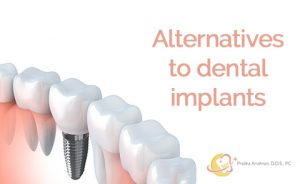Tooth replacement options for missing or loose teeth.

What Are Dental Implants?
Some reading this might be wondering: “What are dental implants and why might I need them?”
Dental implants have been used since 1950 when Leonard Linkow was the first to insert metal implants into the jaw. Once the metal implants, made from titanium, were inserted artificial teeth were then placed onto the implants. In 1965 Brånemark placed his first titanium dental implant into a willing volunteer. Dental implants (tooth replacement options) are surgical components that are inserted into the jawbone allowing the bone to fuse with the implant within months. Dental implants are used to replace missing teeth and or create a dental bridge. Missing teeth or damaged gums are caused by improper dental hygiene, smoking, and family genetics. Tooth replacement options, such as dental implants, can keep your mouth looking healthy and natural.
Dental Implant Procedure
The dental implant procedure involves three parties. Your dentist, the recommended periodontist, and you. You need to first consult with your dentist about whether you actually need dental implants or not, which implant is best for you, and discuss a timeline for before and after the tooth replacement procedure. Your dentist will then recommend, or you can find one, a periodontist to perform the procedure. It is important to make sure you do your research on the periodontist to prevent any problems, such as peri-implantitis. Such problems can affect the hard and soft tissue surrounding the implant that causes bacterial infections and inflammation. Once you have consulted with the periodontist about which type of dental implant you are going to be having, endosteal implants or subperiosteal implants, you can start to make preparations. Endosteal implants are typically shaped like screws, cylinders, or plates and are placed in the jawbone. Subperiosteal implants are for those who have a shallow jawbone or cannot undergo a procedure to fix it. Subperiosteal implants are placed on the jawbone but under the gum. Endosteal implants are the more common implants we see today. There are different types of dental implants that come in various sizes and heights. Consult with your dentist and periodontist to see which type of dental implant is best for you.
Dental Implant Alternatives
Dental implants can seem like a good solution for your missing tooth, but with the recent issues connected to failing dental implants, such as peri-implantitis, alternatives to dental implants are becoming more common. A tooth-supported fixed bridge, removable partial dentures, and a resin-bonded bridge are all dental implant alternatives for replacing a single tooth. A removable partial denture is an alternative for replacing multiple teeth and a removable complete denture is an alternative to dental implants for all your teeth.
The supported fixed bridge, alternative to a dental implant, uses the surrounding teeth where the missing tooth is located to support the bridge. This alternative does require the two surrounding teeth to be grinded down to make room for the bridge and to create stability for the new artificial tooth. This dental implant alternative requires regular maintenance to make sure the adjacent teeth are healthy and strong.
Removable partial dentures are commonly used to replace multiple teeth in a row. This dental implant alternative is removable and can be a less expensive solution to filling missing teeth with an artificial option. This solution seems more natural over time as the color of your natural teeth rubs off on the artificial teeth.
Removable complete dentures are a solution for those who are missing all of their teeth. The dental implant alternative sits on top of the gums where the teeth were previously and is a low-cost alternative. The dentures can be removed at any time and can fill your mouth with artificial teeth to bring your smile back.
Save Your Teeth with LANAP®
While dentures can help with missing teeth or loose teeth, the LANAP® procedure (using the PerioLase MVP-7™ laser) can help save your natural teeth before the need for dental implants. Regular dental checkups and good dental hygiene at home are the two best methods to keeping a healthy mouth. However, due to genetics, if one of your parents had dental problems in the past then you are more susceptible to needing dental implants. The LANAP® procedure can help fight the need for dental implants and prolong the life of your natural teeth. The LANAP® procedure accurately targets the infected gum tissue to fight gum disease. The procedure kills the harmful bacteria causing the gum disease, removes the infected tissue, and creates a new layer of healthy tissue. The treatment is non-invasive, pain-free, and proven effective with hundred of successful procedures.
For more information on alternatives to dental implants or about the LANAP® procedure in Forest Hills, NY click here. Or contact our office on 718.878.4878.

